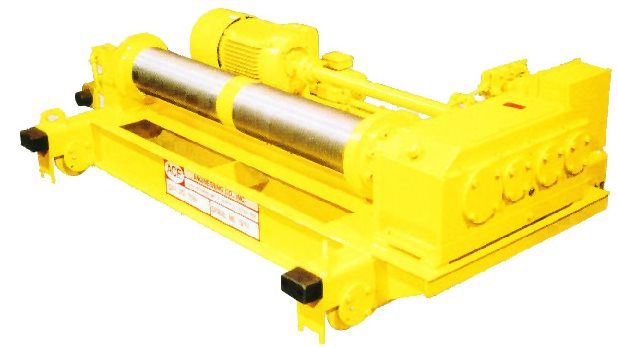Understanding the difference between an open winch and a built-up hoist will help end users make informed buying decisions, says Tad Dunville.
Too often an open winch hoist is installed where a built-up hoist would be more appropriate, particularly in the long term. In the main, this is because there are differentiating characteristics that are not widely understood.
It’s worth noting at the outset that a purchasing decision maker can choose a different brand or manufacturer of components than the overhead crane. Sometimes the wrong hoist is chosen because the crane salesperson insists on their brand being used and/or the end user isn’t equipped with the knowledge to suggest an alternative. This can be particularly problematic in certain applications if a crane manufacturer pushes a customer towards an open winch.
The first thing to understand (accept, even) about open winches is that they’re essentially oversized packaged hoists. They’re not necessarily low-end, built-up, or affordable alternatives that will offer the same reliability and serviceability.
My intention isn’t to present a case that built-ups are always the better choice because they’re not. My company offers open winches that are a suitable mid-range product for a myriad of applications where cranes operate at moderate duty. Where an application might be too demanding for a standard packaged hoist, an oversized (open winch) version might be a suitable alternative.
At a steel distribution center where a hoist sees rapid repeat motor starts and lifts at 25% to 50% of its capacity repeatedly, an open winch will certainly suffice. I’d readily present one as the appropriate solution during a sales process related to such an application. However, in a large steel or paper mill, for example, where high-duty cycle operation is integral to the ongoing production of the facility, a built-up should be the only consideration.
There are two main reasons why the capability of an open winch is overstated. First, sales and marketing campaigns beef them up; they might be presented as a replacement for a true built-up because they are a similar size and layout, in an application to which they aren’t suited. Related to the same causation, a crane sales guy or gal might be looking for a quick sale and present the option with a lower initial purchase price. This is the case in, say, 75% of bad purchasing decisions. Second, the relatively cheaper purchase price of an open winch hoist is favorable to the user.
There are some synergies between the open winch and built-up units in that they are similar in size and both boast ‘durable’ hoists and trolleys. However, there are many differences, largely related to serviceability, which is really the crux of this article.
There are many questions to ask oneself at the outset of any overhead crane and hoist purchasing process. Among them should be: How important is the crane to the facility’s production? What is the required duty cycle? How costly is the downtime? How quickly can I get it fixed and operational again as a result of a breakdown? Do I understand how packaged, open winch, and built-ups compare?
Open winch hoists are designed to last longer than packaged but they’re not really easier to take apart, service or repair. That might be the first time you’ve heard that! They’re cheaper to manufacture than a built-up because the components (motor, gearbox, etc.) are typically flange-mounted, making it a labor-intensive operation to remove them or access parts for inspection.
On a built-up, meanwhile, the components are foot-mounted, each attached to the platform of the trolley. Further, the sheaves are top-mounted to facilitate ease and speed of inspection, maintenance, and repair.
To remove the drum on an open winch, the whole unit might have to be taken apart and even the gearbox cracked open. Similarly to packaged hoists, the gearbox on an open winch can be troublesome to open and investigate; it might need to be taken to a workbench and drained of oil before any further procedures can begin. By contrast, on a built-up, the gearbox is horizontally split to allow easy access.
I’ve heard of some crane manufacturers quoting six-week delivery times on replacement parts for open winches. Imagine the downtime and related costs incurred at a busy steel mill if that’s the case; it’s incomprehensible. Some of these parts have to be shipped from China or Eastern Europe, adding further complication and delay. In most cases where a built-up is installed, the manufacturer has replacement parts available and can get the crane operational again within a few days.
Another advantage of a built-up is the extent to which they can be customized. Owing to the extra space available on the trolley, a user can specify reels, alignment pins (to help the block stay stationary), auxiliary hoists, below-the-hook attachments, and so on, to tailor the solution to their application. Packaged and open winch hoists provide nowhere near the same level of customization, instead offering only a small selection from standard options.
In conclusion, I’ll share a tip for buyers: ask your overhead crane and hoist manufacturer to outline the maintenance procedure for key components, for example, a gearbox in advance of making your purchasing decision. Go a step further and ask to visit the manufacturer to see the gearbox manufacturing process. Watching assembly is hugely insightful and means there are no surprises or mysteries when a breakdown or maintenance situation presents itself.
Select your next hoist diligently.
Tad Dunville
Membership Committee Chairman and Board of Directors, Crane Certification Association of America

Posted on at
ACE World Companies ©2025 Back to Top
